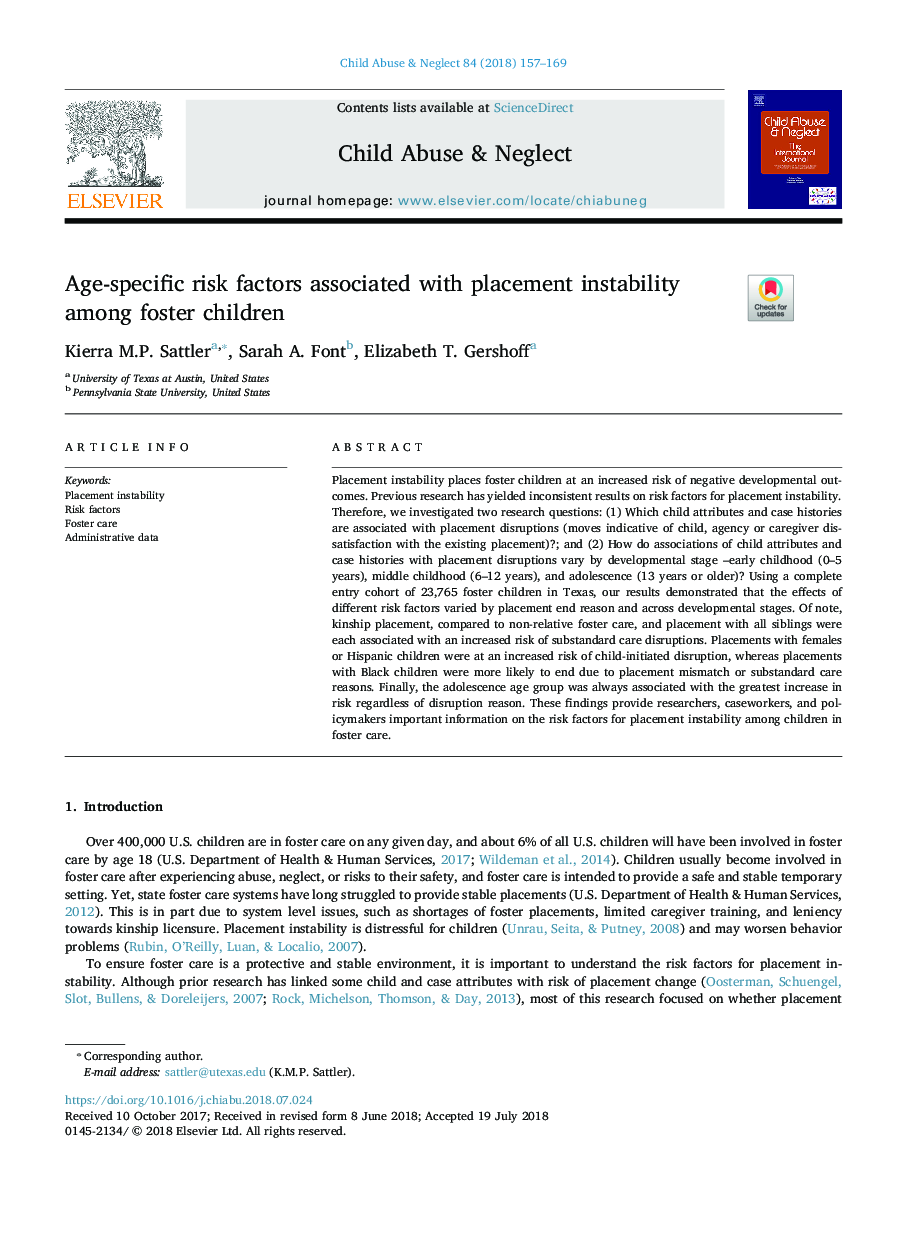| کد مقاله | کد نشریه | سال انتشار | مقاله انگلیسی | نسخه تمام متن |
|---|---|---|---|---|
| 6831705 | 1434344 | 2018 | 13 صفحه PDF | دانلود رایگان |
عنوان انگلیسی مقاله ISI
Age-specific risk factors associated with placement instability among foster children
ترجمه فارسی عنوان
عوامل خطر پیری مرتبط با بی ثباتی قرار دادن در میان فرزندان پرستار
دانلود مقاله + سفارش ترجمه
دانلود مقاله ISI انگلیسی
رایگان برای ایرانیان
کلمات کلیدی
بی ثباتی قرار دادن عوامل خطر، نگهداری فرزند، داده های اداری،
ترجمه چکیده
بی ثباتی قرار دادن، کودکان را در معرض خطر بالقوه نتایج منفی رشد قرار می دهد. تحقیقات قبلی نتایج نامطلوب در مورد عوامل خطر برای بی ثباتی قرار داده است. بنابراین، ما دو سوال تحقیق را مورد بررسی قرار دادیم: (1) کدام ویژگی های کودک و تاریخچه پرونده ها با اختلالات قرار دادن مرتبط است (حرکت نشان دهنده نارضایتی کودک، آژانس یا مراقب با قرار دادن موجود)؟ و (2) چگونه ارتباطات از ویژگی های کودک و تاریخچه موارد با اختلالات قرار دادن متفاوت است مرحله توسعه - دوران کودکی (0-5 سال)، دوران کودکی متوسط (12-12 سال) و نوجوان (13 سال یا بالاتر)؟ با استفاده از یک گروه داوطلب ورود به مطالعه از 23،765 فرزند پرستار در تگزاس، نتایج ما نشان داد که اثرات عوامل خطرزا متفاوت به دلیل دالیل پایان کار و در مراحل تکاملی متفاوت است. توجه داشته باشید که قرار دادن خویشاوندی، در مقایسه با مراقبت های پرستار غیر نسبی و قرار دادن با همه خواهر و برادر، هر یک با افزایش خطر ابتلا به اختلالات مراقبت های نا مناسب همراه است. قرار دادن زنان یا کودکان اسپانیایی در معرض خطر افزایش اختلال در شروع کودکتان بود، در حالیکه قرار دادن فرزندان سیاه بیشتر به علت عدم هماهنگی قرار دادن یا دلایل مراقبت غیرمستقیم بود. در نهایت، گروه سنی نوجوانی همواره با بیشترین افزایش در ریسک بدون در نظر گرفتن علت اختلال همراه بود. این یافته ها به محققین، متخصصان حقوقی و سیاست گذاران، اطلاعات مهمی را درباره عوامل خطر برای بی ثباتی در میان کودکان در مراقبت های پرستاری ارائه می دهد.
موضوعات مرتبط
علوم پزشکی و سلامت
پزشکی و دندانپزشکی
پریناتولوژی (پزشکی مادر و جنین)، طب اطفال و بهداشت کودک
چکیده انگلیسی
Placement instability places foster children at an increased risk of negative developmental outcomes. Previous research has yielded inconsistent results on risk factors for placement instability. Therefore, we investigated two research questions: (1) Which child attributes and case histories are associated with placement disruptions (moves indicative of child, agency or caregiver dissatisfaction with the existing placement)?; and (2) How do associations of child attributes and case histories with placement disruptions vary by developmental stage --early childhood (0-5 years), middle childhood (6-12 years), and adolescence (13 years or older)? Using a complete entry cohort of 23,765 foster children in Texas, our results demonstrated that the effects of different risk factors varied by placement end reason and across developmental stages. Of note, kinship placement, compared to non-relative foster care, and placement with all siblings were each associated with an increased risk of substandard care disruptions. Placements with females or Hispanic children were at an increased risk of child-initiated disruption, whereas placements with Black children were more likely to end due to placement mismatch or substandard care reasons. Finally, the adolescence age group was always associated with the greatest increase in risk regardless of disruption reason. These findings provide researchers, caseworkers, and policymakers important information on the risk factors for placement instability among children in foster care.
ناشر
Database: Elsevier - ScienceDirect (ساینس دایرکت)
Journal: Child Abuse & Neglect - Volume 84, October 2018, Pages 157-169
Journal: Child Abuse & Neglect - Volume 84, October 2018, Pages 157-169
نویسندگان
Kierra M.P. Sattler, Sarah A. Font, Elizabeth T. Gershoff,
